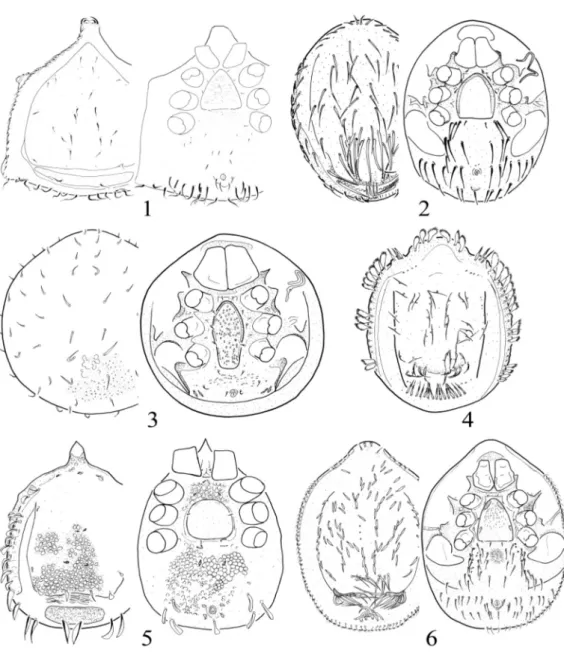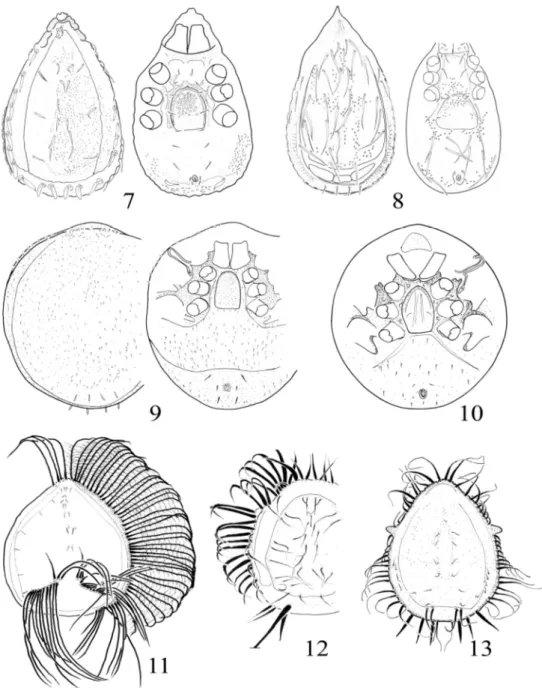JENŐ KONTSCHÁN*
NOTES ON THE UROPODINA MITES
(ACARI: MESOSTIGMATA) OF THE NEOTROPICAL REGION Abstract:
Introduction
Uropodina mites are small (300-1200 µm long), reddish-brown animals, which occur in soil, moss, leaf-litter, dunk, tree-bark and lichen. These mites can be found on the whole world, we know species from the cold Antarctic region to the warm and wet tropical rain forests. The last summarizing work (Wiśniewski
& Hirschmann 1993) contained more than 2000 species, but after the publication of this work more than 100 new species were described from all over the world.
The adult Uropodina mites can be easily recognized by the shape of hypos- tomal setae, shape of tritosternum and epistome, the fusions of the sternal- ven- tral and anal shields and the shape of the genital shield of females and males.
The history of Neotropical Uropodina mite studies
The Neotropical region is one of the well investigated parts of the world, re- cently more than 500 species are known from this region. The first Uropodina mites were described by Gervais (1844) who presented the species Pseudouro- poda moneta (Gervais, 1844) from the Mexican region. After that several noted and famous acarologists described new species from the Neotropical region, in alphabetic order: N. Banks, A. Berlese, J. H. Camin, I. Fox, S. Hirst, P. Kramer, G. Leonardi, G. Lombardini, A. C. Oudemans, M. Sellnick, O. Stoll, H. G. Vitz- thum, G. W. Wharton and E. Trouessart. After 1960 Werner Hirschmann and his co-workers – namely Nabo Hiramatsu, Irene Zirngiebl-Nicol and Jerzy Wiśniewski – began their work on the fauna of the neotropical region describing more than 300 new species from there, most of them were collected during the Hungarian Soil Zoology Expeditions. These expeditions were lead by Prof.
János Balogh who was the first Hungarian world-wide noted acarologist. Several famous and noted zoologists participated in these field trips, such as Prof.
*Systematic Zoology Research Group, Hungarian Academy of Sciences, Department of Zoology, Hungarian Natural History Museum. H-1088 Budapest, Baross u. 13. Hungary. E-mail:
Sándor Mahunka acarologist, Prof. András Zicsi earthworm specialist, Prof.
István Andrássy nematologist, and Dr. Imre Loksa springtail specialist. Werner Hirschmann and his co-workers described more than a thousand of new species from these field trips (not only the Neotropical region, but from all over the world). Werner Hischmann dedicated a lot of species to the members of these expeditions and created several strange, funny and terrible names, as genera Baloghbrasiluropoda Hirschmann, 1973, Kaszabjbaloghia Hirschmann, 1973, Baloghjkaszabia Hirschmann, 1973, or as species from Cuba Trigounuropoda cubazicsiia Hirschmann, 1975; T. cubamahunkaia Hirschmann, 1975; T. cu- baandrassyia Hirschmann, 1975; T. cubabaloghia Hirschmann, 1975 and T.
cubaloksaiaHirschmann, 1975.
Next to Hirschmann and his co-workers, several other excellent acarologists studied the Neotropical Uropodina fauna, e.g. J. Bloszyk, F. Athias-Binche, W.
Karg, J. Kethley and G. W. Krantz. Recently Magdalena Vazquez, Hans Klop- pen and the author of this paper investigate the Uropodina mites of this region also.
Composition of the Neotropical fauna
Most of Uropodina mites have a cosmopolitan distribution type. The species of these genera are prevalent and abundant on every continent, with a high spe- cies number. Unfortunately these genera are large, catch all genera; their syste- matic position needs to be revised. For example the genus Uropoda is distributed on every continent; however there are several lower taxa in this genus (e.g. sub- genus or species group) with special characters which should be elevated to higher taxonomic levels. Several present species groups of Uropodaare charac- terized by a significantly smaller separated areas (for example the members of Uropoda multipora-group have a typical Neotropical distribution (Wiśniewski &
Hirschmann 1993)). By establishing new genera on numerous morphological evidences, the problem of the hypotetic cosmopoitan, catch-all genus could pos- sibly be resolved.
The position of several endemic taxa is also questionable. A typical example is the position of the genus Tetrasejaspis Sellnick, 1941 which was placed for- merly in the family Uropodidae. The family Uropodidae belongs to the superfa- mily Uropodoidea where basal part of tritosternum is narrow and it is covered by coxae I. The species of the genus Tetrasejaspis have wide gap between coxae I and their tritosternal basis is wide, hence this genus can not belong nor to the superfamily Uropodoidea neither to family Uropodidae. I have to re-establish the family Tetrasejaspidae Hirschmann, 1979 with the single genus Tetrasejaspis (Kontschán 2008a), therefore this genus does not belong to the cosmopolitan family Uropodidiae but it is handled as a member of an endemic Neotropical family.
Subdivision of the Neotropic Uropodina taxa
1, Cosmopolitan distribution: Most of the species belong to this group. The common character is the world-wide distribution: such as genera Uroobovella Berlese, 1903; Trichouropoda Berlese, 1916; Uropoda Latreille, 1806; Nenteria Oudemans, 1915 etc. Presumably they are ancestral taxa, with a Pangaean ori- gin.
2, Circumtropical distribution: Several genera are characterized by this distri- bution type. These genera can be found in tropical Africa, South-East Asia and the Neotropic region. The following taxa have typical circumtropical distribu- tion: Deraiophorus Canestrini, 1897; MacrodinychusBerlese, 1917; Rotundaba- loghia Hirschmann, 1975; Trigonuropoda Trägardh, 1952. According to my assumption these taxa are younger than the previously mentioned, with a pre- sumable Gondwanaland origin.
3, Amphiatlantic distribution: Only one genus with four described species be- longs to this type – Afrotracyhtes Kontschán, 2006 –, which occur in tropical Africa (Cameroon, Tanzania and Angola) and the Neotropical region (one de- scribed species from Ecuador (Kontschán 2009a) and some undescribed species from Brazil and Colombia). I suppose that this group must have been developed during a geological period when the African and South-American continents were still connected but separated from the other continents. This connection was during the upper Cretaceous, ca. 80 million years ago.
4, Amphipaciphic distribution: Not any genera have this distribution type, but there is one species group with species characterized by wide, pilose marginal setae placed on small protuberances. These species were moved into the Uroo- bovella elegans-group and recently we know eleven species of them. Ten of former species occur in South-East Asia and New Guinea and one species is distributed in South-America, in Ecuador and Costa Rica (Wiśniewski & Hir- schmann, 1993; Kontschán, 2009b). This distribution type can not been ex- plained by traditional zoogeographical theories, it can only be understood with the aid of panbiogeography, which supposes a panbiographic track in the Pacific Ocean.
5, Endemic distribution: The endemic taxa occur only in the Neotropical re- gion. Two types can be distinguished. The first type has wide distribution in the Neotropic (occuring from Central America to Northern part of South America), such genera for example: Clausiadinychus Sellnick, 1930, Kaszabjbaloghia Hirschmann, 1973; Brasiluropoda Hirschmann & Zirngiebl-Nicol, 1964; Tri- chouropodella Hirschmann & Zirngiebl-Nicol, 1972. The second type occur
Baloghiatrigon Hirschmann, 1979 (in the genus Trigonuropoda) can be found only the Caribbean Islands (Kontschán 2008b), or the species of the genus Ba- loghjkaszabia Hirschmann, 1973 occur only in a small region of Brazil.
Conclusion
After studying several soil samples of the Neotropical region it seems that most of the unidentified species are new to the science. In my opinion only the 10% of the Neotropical Uropodina fauna is known, which show similarity with the results of Vazquez & Klompen (2007).
References
GERVAIS, P.(1844): Hist. Nat. Insectes Apteres. 3: 223.
KONTSCHÁN, J. (2008a): A review of the Neotropical family Tetrasejaspidae (Acari:
Uropodina) with descriptions of three new species. Opuscula Zoologica Budapest 37: 29–42.
KONTSCHÁN, J.(2008b): Trigonuropoda (Baloghiatrigon) dominicana sp. nov. from the Dominican Republic, with notes on the subgenus Baloghiatrigon Hirschmann, 1979 (Acari: Uropodina: Trigonuropodidae). Zootaxa1856: 55–66.
KONTSCHÁN, J.(2009a): Remarks on the genus Afrotrachytes Kontschán, 2006 (Acari:
Uropodina), with description of two new species. Opuscula Zoologica Budapest 40(2): 41–46.
KONTSCHÁN, J.(2009b): Uropodina mites (Acari) collected in Costa Rica, 1. Opuscula Zoologica Budapest 40(1): 23–33.
VÁZQUEZ, M.M. & H. KLOMPEN. (2007): New records of Uropodina mites from México, Guatemala, Belize and Costa Rica.Dugesiana 14(1):27–37.
WIŚNIEWSKI, J. & HIRSCHMANN, W. (1993): Gangsystematik der Parasitiformes Teil 548. Katalog der Ganggattungen, Untergattungen, Gruppen und Arten der Uropodiden der Erde. Acarologie. Schriftenreihe für Vergleichende Milbenkunde 40: 1–220.
WIŚNIEWSKI, J. (1993): Gangsystematik der Parasitiformes Teil 549. Die Uropodiden der Erde nach Zoogeographischen Regionen und Subregionen geordnet (Mit Angabe der Lande). Acarologie. Schriftenreihe für Vergleichende Milbenkunde 40: 221–291.
Legends:
Figs 1-6. Neotropical Uropodina mites. 1-3: Circumtropical genera (1: speci- es from genus Deraiophorus from Brasil, 2: species from genus Trigonuropoda from Costa Rica, 3: species from genus Rotundabaloghia from Ecuador), 4:
amphipaciphic taxa (species from Uroobovella elegans-group from Costa Rica), 5: amphiatlantic genus (Afrotrachytes species from Ecuador), 6: endemic subge- nus (species from subgenus Baloghiatrigonfrom Dominican Republic).
Figs 7-13. Endemic Neotropical Uropodina mites. 7: species from the genus Kaszabjbaloghia, 8: species from the genus Tetrasejaspis, 9: species from the genus Trichouropodella, 10: Brasiluropoda, 11: species from the genus Clau- siadinychus, 12 and 13: members of endemic species groups from the genus Uropoda.

